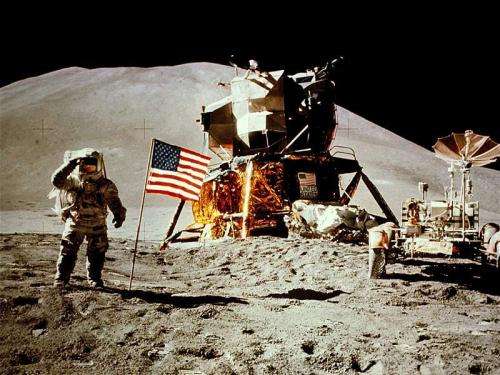Image from Apollo 15. Credit: NASA
This month is the 40th anniversary of the Apollo 15 launch. This mission was the eighth manned mission in the Apollo program and the fourth to the Moon. The Apollo 15 mission is important because it was another step in manned exploration bringing more advanced scientific tools for exploration of the Moon. The mission demonstrates the importance that advanced technology has in further manned space exploration. This is perhaps an important thing to remember with the recent conclusion of the U.S Space Shuttle program.
The Apollo 15 mission launch happened July 26, 1971 around 9:30 AM in the morning. The Apollo 15 spacecraft entered translunar orbit later at 12:30. The mission was to cover 4 main objectives. First the crew was to perform selenological inspections and surveys on the lunar surface. This included investigating surface features and obtaining material samples from the selected Hadley-Appennius area of the Moon. The next mission goal was to emplace and activate surface experiments. Next the crew was to evaluate the capability of the Apollo equipment to provide extended lunar surface stay time. The final objective was to conduct inflight experiments and complete photographic tasks from lunar orbit.
In the entire mission lasted 12 days from initial launch to splash down. Like all other Apollo missions the crew consisted of three astronauts. The mission commander was David R. Scott who was completing his third space flight. The command module pilot and lunar module pilot were Alfred M. Worden and James B. Irwin. For both pilots it was their only space flight. Like all lunar missions, one of the pilots remained while the lunar module pilot and the commander went to the surface to complete the surface portion of the mission.
One unique feature introduced for the first time to the Apollo program on the Apollo 15 mission was the lunar roving vehicle. The LRV was a four wheeled manually controlled electric vehicle designed for exploration of the lunar surface. The craft could carry two astronauts and a scientific payload at up to 16 km per hours. This allowed for astronauts to explore more of the lunar surface within the limited time frame of a lunar mission.
The Apollo 15 mission provided some of the most iconic images of manned lunar exploration. As the 40th anniversary of the Apollo 15 launch arrives it is a great moment to look back at the great strides that manned space exploration achieved and recommit ourselves to expanding its capabilities and horizons in future missions.
Source: Universe Today




















